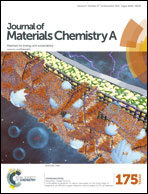Synthesis of α-Fe2O3/carbon nanocomposites as high capacity electrodes for next generation lithium ion batteries: a review
Abstract
Graphite, widely employed as an anode in LIBs, is limited by a theoretical capacity of 372 mA h g−1. Progress in nanoscience and energy storage systems has brought attention to nano-sized α-Fe2O3 as next-generation anodes, providing capacities up to three times higher than graphite. However, mass-market application remains challenging due to a long-term cycling capacity loss, the intrinsic low conductivity and safety concerns regarding the “nano-nature” of α-Fe2O3 nanoparticles. Promising solution concepts include the embedding of α-Fe2O3 into conductive sp2 derived carbons with volume-buffer capabilities. This review article presents the current status of α-Fe2O3/carbon nanocomposites with superior electrochemical performance based on 2D graphene, 1D carbon nanofibers and 1D carbon nanotubes.


 Please wait while we load your content...
Please wait while we load your content...